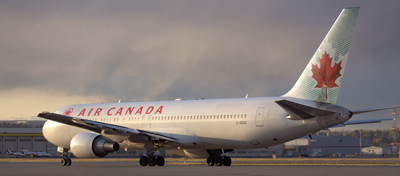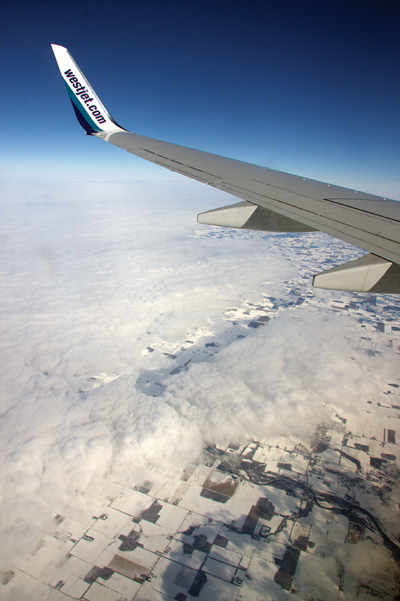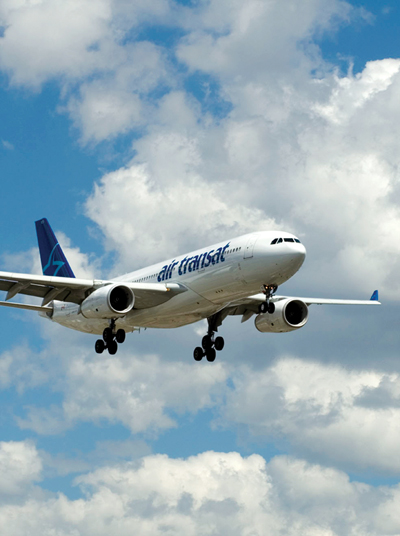
Features
Operations
Smarter in the Fight
Written off as old, lumbering, with too much baggage to adjust, there are signs of life in the legacy airlines yet. It would have been the cruellest of jokes
November 27, 2009 By David Carr
Written off as old, lumbering, with too much baggage to adjust, there are signs of life in the legacy airlines yet. It would have been the cruellest of jokes; surviving the recession only to fail the recovery. Yet legacy carriers – fat and burdened by operating costs one-third higher than their leaner low-cost rivals, handcuffed by excessive regulation and helpless to stem the bleeding from premium-class cabins – have run out of quick-fix options. That will be their salvation.
 |
|
On the surface the picture looks bleak. With a 36 per cent share of the domestic market, WestJet has Air Canada sufficiently on the ropes to capture a 50 per cent share by 2013. Should that take place, Air Canada would see its market share crumble below half. Air Canada spun off its remaining stake in the Jazz regional feeder airline in 2008. Porter Airlines, which operates out of Toronto’s convenient downtown airport, is grabbing passengers on choice short-haul routes from Air Canada’s (and to a lesser extent, WestJet’s), Pearson hub. Business isn’t much brighter at British Airways. After reinventing itself in the 1980s from what Business Week described as “bloody awful to bloody awesome,” British Airways placed most of its eggs in the premium-cabin basket, stripping out economy seats to create more room for its first and business class offering. The strategy was a money-spinner in the good times, but has left the airline vulnerable to a 20 per cent plunge in premium market travel. Japan Air Lines (JAL) has gone cap in hand to the government on three separate occasions since 2001. It is preparing the begging bowl one more time despite receiving a $1.2 billion bailout in June. JAL is planning to ground airplanes, shed 14 per cent of its workforce and slash 50 routes over three years. Japan’s new minister of transport says that is not enough. It is likely that either oneworld alliance partner American Airlines or rival Delta Airlines, part of the SkyTeam alliance, will take a $360 million stake in the struggling airline, although nothing is certain in multinational consolidations.
The International Air Transport Association (IATA), which represents 93 per cent of the world’s scheduled airlines, is forecasting that its members will lose more than $11 billion in 2009. The belly of the beast isn’t doing any better, with cargo operations estimated to lose approximately $4 billion. In comparison, low-cost carriers continue to thrive, although the economic downturn has taken its toll. WestJet posted a second-quarter profit of $9.2 million, a 40.7 per cent year-over-year decline, but better than Air Canada’s second-quarter loss of $113 million compared with a $7 million gain in 2008.
 |
|
All budget airlines are low-cost airlines, but not all low-cost carriers are budget. As British Airways chief executive Willie Walsh is quoted as saying in the New York Times, “low cost doesn’t mean low fare. There is a lower cost base, but it is still a premium product.” Canada has not had a genuine low-fare carrier similar to Southwest in the United States or easyjet and Ryanair in Europe since Jetsgo was grounded in 2005. With fares comparable to Air Canada but costs 36 per cent lower, WestJet is free to capture a greater share of the domestic air transport surplus. The low-cost revolution is no longer a phenomenon. Low-costs came into their own after 9-11 and SARS, but still legacies have struggled to compete with their leaner, more efficient, rivals. Even after flights through bankruptcy protection, Air Canada, United and others have failed to bring internal costs within striking distance of the low-costs. The cost per employee at Air Canada has remained a stubborn three times greater than WestJet. Earlier tries to rein in higher operating costs by introducing lower-cost subsidiaries such as Air Canada’s Tango and Zip, Delta’s Song, and United’s Ted have failed in North America, likely because costs were still not low enough and the mainline carriers, still hooked on premium fare revenue, were hesitant to shift too much traffic to their budget offspring.
British Airways, which sold its own budget baby Go Fly to easyjet in 2002, is gambling that it can apply the low-cost business model to an upmarket subsidiary, OpenSkies. Taking advantage of the recent U.S./Europe bilateral, which allows airlines to connect with America from any point in Europe, OpenSkies is a streamlined, all-premium-class-subsidiary without the costly baggage of its parent. The first flight from Paris to New York took off in June. So far it’s not coming up trumps. After talking of adding several European cities before the end of 2009, British Airways suspended a similar service from Amsterdam to New York and is reported to be seeking a buyer for a majority stake in its premium subsidiary.
Confronted by the immovable object of higher costs and reluctant to trim the excesses of their premium-class product, the legacies took the path of least resistance – the rear cabin, copying some of the deeper discounters by adding seats, eliminating frills and charging for basics such as baggage check-in, seat selection and telephone reservations. Passengers shelled out approximately $11 billion for ancillary products and services in 2008, equal to what IATA airlines are expected to lose in 2009. United Airlines is expected to raise US$1.1 billion this year in ancillary revenues such as ticket change fees, in-flight food sales and baggage fees. In the first six months of this year, the top 10 U.S. carriers have raked in $670 million on baggage check fees alone. But it is a strategy that could potentially backfire if legacies fail to distinguish their economy class product from that of the low-cost, especially if a return of the premium passenger lags the economic rebound.
 |
|
No carrier will emerge from the downturn without having been bruised in its core market segments. The traffic slump has caused WestJet to stretch deliveries for the bulk of new Boeing 737s to 2016, and while some analysts are predicting up to 10 per cent growth for the carrier in 2010, lower fares will continue to depress earnings. But even if the low-cost airline’s traditional market stays home at least temporarily, the low-cost model, with high frequencies, newer fleets and a stronger emphasis on amenities, is positioned to fill the void by capturing a larger share of the price-sensitive business traveller. Bleeding in the front cabin and vulnerable to low-cost attacks in the back, where does this leave the legacies, especially during the slow winter travel season?
A thawing of capital markets has eased the liquidity crisis faced by some of the largest legacies. According to U.K.-based Airline Business, six airlines raised $4.5 billion in July, including Air Canada, which has raised over $1 billion from a patchwork of sources including $600 million from a consortium of lenders made up of GE Canada Finance Holdings, Export Development Canada, Aeroplan and its parent, ACE Aviation Holdings. In September, American Airlines announced it had secured US$2.9 billion in financing by selling and leasing back 84 Boeing 737-800s to GE Capital Aviation Services and $1 billion from Citigroup for the advance sale of frequent-flyer miles. A portion of the financing is expected to go to American’s attempt to purchase a stake in struggling Japan Air Lines. The return of capital markets is an encouraging vote of confidence in the future of legacies. Still, the recovery will be slow, with the International Air Transport Association not expecting an industry-wide return to profit until 2011 at the earliest.
There is no shortage of arrows in the legacies’ quiver, including global alliances, upgrades and powerful loyalty programs such as Aeroplan. Air Canada, Continental Airlines, Lufthansa and United Airlines have proposed a joint venture called Atlantic Plus – essentially an alliance within the existing Star Alliance (which Continental joined in October) that would maximize the advantage of open skies agreements between North America and Europe through greater collaboration on pricing, schedules and revenue splitting on transatlantic services. Atlantic Plus has already received anti-trust immunity in the United States, against the objections of the U.S. Justice Department, and is hoping for a green light from the European Union. But Europe’s Competition Bureau has raised several red flags to a similar tie-up between American Airlines, British Airways and Spain’s Iberia. (British Airways is expected to complete a take-over deal for Iberia by year’s end). The U.S. was expected to rule on the BA/AA joint venture as Wings went to press. Europe should deliver its verdict on Atlantic Plus at the same time.
There are concerns over such ventures. The BA/AA hookup would give the airlines a monopoly on the Heathrow/Dallas route and 70 per cent of Heathrow/Boston. Atlantic Plus is a smaller tie-up, but Air Canada and Lufthansa will have a near monopoly between their Toronto and Frankfurt hubs. Shedding routes or some airport slots may be the price of admission. But the process illustrates flaws in the regulatory process when two national regulators rule independently on a multinational hookup.
In comparison to the legacies, low-costs have been slow to form alliances or introduce code-sharing. A planned codeshare agreement between WestJet and Southwest was put on hold earlier this year. The stumbling block has been the integration of reservations systems and a shuffling of Southwest’s revenue generating priorities. Both airlines claim to be committed to the codeshare and now expect it to be in place sometime in 2010. WestJet, Air France and its KLM subsidiary (part of the SkyTeam alliance) are also studying a codeshare agreement that would give WestJet customers easier access to Europe through links at Vancouver, Calgary, Toronto and Montreal.
There are two other battlegrounds likely to open up on the Canadian front in 2010: the seasonal leisure market and Toronto’s City Centre Airport (to be renamed after First World War flying ace Billy Bishop). WestJet Vacations will operate its largest-ever seasonal schedule this winter, adding eight international and three U.S. sunspot vacations. Next summer, Air Canada will launch seasonal service from Montreal and Toronto to Athens and Barcelona using Boeing 767-300ERs, a strategy intended to tie into the growing leisure market including cruises. International packaged holiday operators like Air Transat did not become fodder for the low-costs as was once predicted, but Air Canada and WestJet stepping up their leisure programs adds pressure at a challenging time for the Canadian industry. A glut of unsold packages and cutthroat pricing claimed Conquest Vacations last spring. Signature Vacations likely escaped a similar fate by merging with Sunwing, creating Canada’s second-largest tour operator after Transat. That is one battleground.
The other is the potential return of Air Canada’s Jazz affiliate to Toronto’s downtown airport as early as April 2010. Neither Air Canada nor Halifax-based Jazz has been enthusiastic about operating from the island airport, but never wanted anybody else to. Since 2006, a controversial exclusivity agreement between the airport operator and Porter Airlines blocked Jazz from serving the airport. That agreement is set to expire next spring. Porter appears undeterred. The airline will open a new $45 million 10-gate passenger terminal in April, will take delivery of five more Bombardier Q400s (bringing the fleet to 20), is expected to launch service to Philadelphia and Washington in 2010, and is reported to be considering serving a second New York area airport, possibly La Guardia. There is also speculation that WestJet is interested in buying a stake in the boutique airline.
Everywhere in the industry, airlines are looking to re-solidify their position. Ancillary charges are unlikely to disappear, but legacies could become smarter in how they are marketed, making them less punitive and more value-added according to Alex Cruez, chief executive of Vueling Air, one of Europe’s fastest growing low-costs. United Airlines, for example, is offering economy passengers the opportunity to purchase packages of perks that include roomier seats and access to airport lounges. Air Canada, which recently dusted off its Rapidair brand on the Toronto/Montreal/Ottawa triangle, is also making its Maple Leaf airport lounges available to economy-class passengers for a fee. All legacies are rethinking the configuration of their multi-cabin aircraft, including reducing the size of the premium cabin and eliminating first class altogether, although some are not going down without a fight. In September, British Airways launched an all-premium-class service from London’s own City Centre Airport to New York. Air Canada is considering squeezing an enhanced full-fare economy product to slow the slide from the business-class market out the door to WestJet.
Legacies face other challenges, including enormous pension hangover, an inevitable bump in oil prices and obstructionist governments that continue to be a barrier to consolidation and cabotage, although Canada is moving in the right direction by relaxing foreign ownership regulations by 25 per cent to 49 per cent. More than 30 airlines went bankrupt in 2008 including Canada’s Zoom Airlines. More shutdowns might be needed to shake regulators out of their complacency. One thing is clear, after ceding territory to the low-costs, the legacies are becoming smarter in the fight.